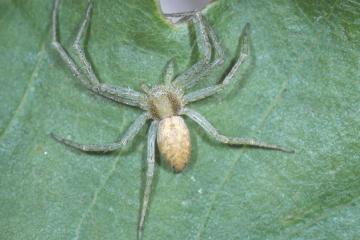Species Account for Philodromus albidus
Philodromus albidus Kulczynski, 1911
Araneae: Philodromidae

Reproduction for study and non-profit use permitted, all other rights reserved.
Taxonomic group: spiders (Araneae) - County data
View time series maps for Philodromus albidus
member log-on for taxon report
Images
upload a new image
National map for Philodromus albidus on Spider and Harvestman Recording Scheme website
Species text
The species is confined to the southern half of England. It is usually found in broad-leaved or mixed woodland on the lower branches of broad-leaved trees such as oak at the edge of clearings or rides. It is also found in old hedgerows and green lanes, with the majority of records from trees or bushes at the edge of clearings or in hedgerows. It seems to have increased in frequency in recent years and is likely to be demoted in status in a forthcoming review. The majority of records are from trees or bushes at the edge of clearings or in hedgerows. Lack of management resulting in the closure of open woodland and the loss of old hedgerows are almost certainly detrimental to this species. Spray drift from the use of pesticides on crops is likely to affect the survival of this spider, as well as many other invertebrates, where arable fields are adjacent to woodland or hedgerows. Management should retain open surroundings by rotational cutting of woodland ride vegetation, periodic control of scrub and tree invasion and light grazing in woodland pasture. The retention of wide field edges and headlands should be encouraged to help maintain a diverse invertebrate fauna and reduce the effects of spray drift on old trees in hedgerows and at the edge of woodland (Harvey et al. 2002). P.R.Harvey 2007. References
Habitats
Recorded management for locations with Philodromus albidus
Recorded substrate and hydrology for locations with Philodromus albidus
Why not join the Club, register and add a new species page
Interpretation of distribution maps
























